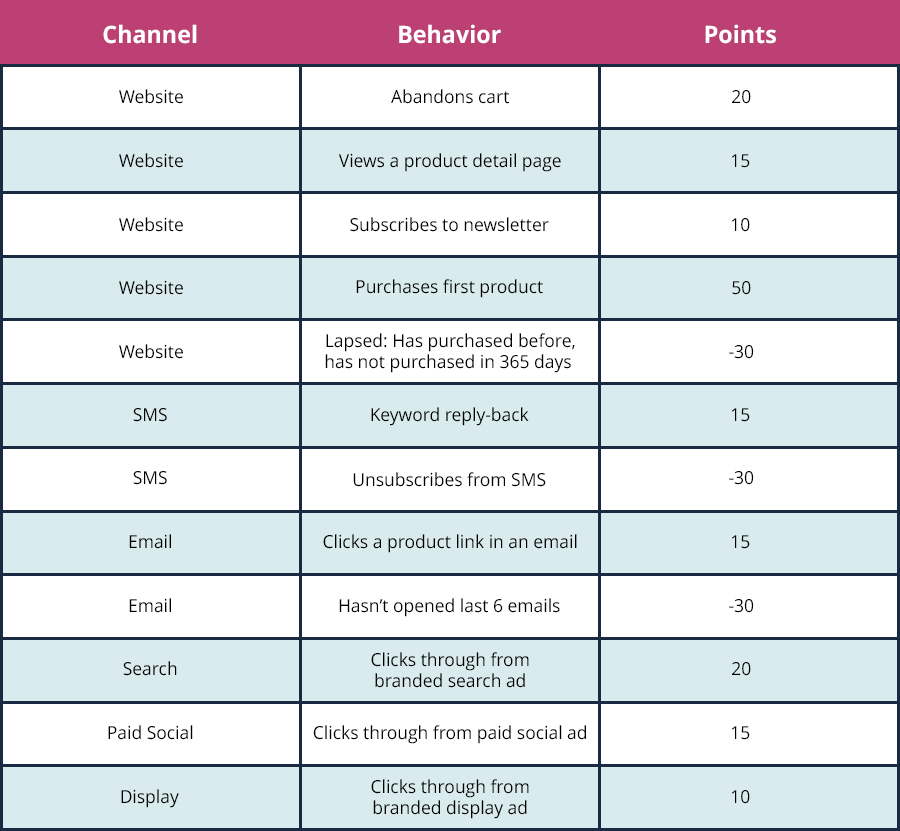To achieve an omni-channel, lead scoring-based nurture strategy, the CDP must be placed at the center of the tech stack. The CDP must be aware of all customer behavior to align an accurate lead score. To achieve this, the CDP must connect to all downstream activation points. In some cases, they must also have a bi-directional connection to platforms to both ingest events into the CDP and push audiences out of the CDP. Common data sources and downstream activation points are websites, lifecycle marketing tools, Google Ads, Meta Ads, etc. Without a CDP in place, lead scoring model strategies lack a 360-view of customer behavior, resulting in messaging that misses the mark.
Align Content to The Appropriate Phase In The Customer Journey
The objective of a lead scoring model is to ensure that content is in sync with each phase of the customer journey. For example, if a prospect is in the research phase, they should receive content that establishes credibility in the brand, specifically regarding the solution you are offering to the customer’s problem and how you differentiate amongst competitors. However, if a prospect is in the decision phase, they should receive a different message, such as a harder-hitting sales message, persuasive case studies, white papers, etc.
Without a source of truth, a single repository for all your key customer behaviors, to create a singular lead score form, strategies become fragmented. This leads to lost opportunities or communications that do not align with current funnel stages. Imagine a prospect is looking for a new pair of jeans and is interested in brand A and brand B. After vetting both brands, they are ready to find the perfect pair with brand B. They start getting targeted paid ads from brand B for best sellers but receive email content that is not aligned with the best seller messaging they are seeing in the paid ads. This can quickly create unnecessary noise and become distracting, and in the worst case, create an unpleasant customer experience. In this circumstance, the brand’s email marketing platform was not receiving cross-channel behavioral updates, and therefore missed key steps in the customer journey.
Set Up A CDP-Based Lead Scoring Table
A lead scoring model built on a 360-degree view of a customer’s behavior is essential. Below is an example table of how one could structure a CDP-based, cross-channel lead scoring model. It’s important to note that customer behavior sources, scores, etc., are variable and will change based on how a business is structured. The objective of a table below is to establish score tiers and align messaging with where they fall in each tier.
Cross-Channel Scoring Example:

For example, let’s assume the table above is a basic lead scoring model based on an e-commerce brand selling apparel. Let’s also assume the scoring threshold for a sales qualified lead is 100 points. If a user has a score between 80 and 100, that user could be deemed “Highly Likely to Purchase”. They should be receiving sales focused messaging specific to the product they’ve shown interest in. If a user is frequently inactive and their score is between 0 and 20, that user should be put into a re-engagement campaign where they receive content focused on product value, brand differentiation, and incentivized offers. The messaging that a user sees should be consistent across all channels based on their CDP lead score.
The Future of Lead Scoring Should Be Based on The Full Customer View
With CDPs becoming more widely implemented due to deprecation of third-party cookies, we will start to see fewer siloed lead scoring strategies. Having a CDP to fuel scoring behaviors will change the way brands interact with customers.
Additionally, a CDP-based lead scoring model will allow brands to achieve cohesive, consistent, cross-channel messaging that’s aligned with the customer journey. This will lead to enhanced outcomes such as better customer experiences, growth in customer lifetime value, and improved ROI through paid channels and lifecycle marketing efforts.
